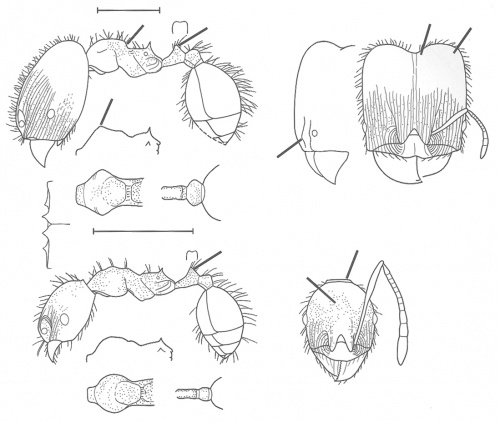Pheidole fera
| Pheidole fera | |
|---|---|

| |
| Scientific classification | |
| Kingdom: | Animalia |
| Phylum: | Arthropoda |
| Class: | Insecta |
| Order: | Hymenoptera |
| Family: | Formicidae |
| Subfamily: | Myrmicinae |
| Tribe: | Attini |
| Genus: | Pheidole |
| Species: | P. fera |
| Binomial name | |
| Pheidole fera Santschi, 1925 | |
Nothing is known about the biology of fera.
Identification
See the description in the nomenclature section.
Keys including this Species
Distribution
Known only from Minas Gerais. (Wilson 2003)
Distribution based on Regional Taxon Lists
Neotropical Region: Brazil (type locality).
Distribution based on AntMaps
Distribution based on AntWeb specimens
Check data from AntWeb
Countries Occupied
| Number of countries occupied by this species based on AntWiki Regional Taxon Lists. In general, fewer countries occupied indicates a narrower range, while more countries indicates a more widespread species. |

|
Estimated Abundance
| Relative abundance based on number of AntMaps records per species (this species within the purple bar). Fewer records (to the left) indicates a less abundant/encountered species while more records (to the right) indicates more abundant/encountered species. |

|
Biology
Castes
Nomenclature
The following information is derived from Barry Bolton's Online Catalogue of the Ants of the World.
- fera. Pheidole guilelmimuelleri var. fera Santschi, 1925d: 227 (s.w.) BRAZIL. Raised to species: Wilson, 2003: 689.
Unless otherwise noted the text for the remainder of this section is reported from the publication that includes the original description.
Description
DIAGNOSIS From Wilson (2003): Similar in various traits to Pheidole amata, Pheidole ambigua, Pheidole celaena, Pheidole germaini, Pheidole peruviana, Pheidole rutilana, Pheidole schwarzmaieri, Pheidole superba and Pheidole vomer, differing as follows.
Major: distinct mesonotal convexity absent in side view, with promesonotal profile a continuous weakly convex curve that drops as a steep face to the metanotum; center of mid-c1ypeal carina projects forward as a process in dorsal-oblique view; posterior half of head smooth and shiny except for carinulae along the dorsal midline, which reach occiput; anterior half of head almost all carinulate, with no rugoreticulum; humeri subangulate in dorsal-oblique view; postpetiole diamond-shaped seen from above; apex ofpetiolar node acute in side view.
Minor: occiput narrowed, with a nuchal collar; apex of petiolar node acute in side view; central third of dorsum of head and almost all of meso soma foveolate.
MEASUREMENTS (mm) Lectotype major: HW 1.96, HL 1.24, SL 0.94, EL 0.24, PW 0.76. Paralectotype minor: HW 0.64, HL 0.74, SL 0.84, EL 0.14, PW 0.44.
COLOR Major: head and mandibles light reddish brown; rest of body plain medium brown; other appendages dark yellow.
Minor: body plain dark brown, appendages plain light brown.
Figure. Upper: lectotype, major (dorsal-oblique view of meso soma and dorsal view of petiole based on paralectotype major). Lower: paralectotype, minor. Scale bars = 1 mm.
Type Material
BRAZIL: Minas Gerais. Naturhistorisches Museum, Basel - as reported in Wilson (2003)
Etymology
L fera, wild, untamed. (Wilson 2003)
References
- Wilson, E. O. 2003. Pheidole in the New World: A dominant, hyperdiverse ant genus. Harvard University Press, Cambridge, MA. (page 689, fig. major, minor described, Raised to species: new status)
- Guerrero, R.J., García, E., Fernández, F. 2022. The Pheidole Westwood, 1839 ants (Formicidae: Myrmicinae) in Colombia: new records including two species with remarkable morphology. Zootaxa 5154 (3): 319-332 (doi:10.11646/zootaxa.5154.3.5).
- Santschi, F. 1925d. Nouveaux Formicides brésiliens et autres. Bull. Ann. Soc. Entomol. Belg. 65: 221-247 (page 227, soldier, worker described)
References based on Global Ant Biodiversity Informatics
- Kempf, W.W. 1972. Catalago abreviado das formigas da regiao Neotropical (Hym. Formicidae) Studia Entomologica 15(1-4).
- Santschi F. 1925. Nouveaux Formicides brésiliens et autres. Bulletin et Annales de la Société Entomologique de Belgique 65: 221-247.


